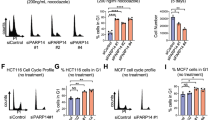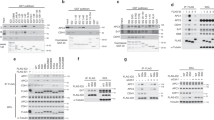Abstract
The E2F proteins form a family of transcription factors that regulate the transition from the G1 to the S phase in the cell cycle. E2F activity is regulated by members of the retinoblastoma protein (pRb) family, ensuring the tight control of E2F-responsive genes. During the G1 phase, phosphorylation of pRb by cyclin-dependent kinases (CDKs), most notably cyclin D–CDK complexes, releases pRb from E2F, facilitating cell-cycle progression by the timely induction of E2F-targeted genes such as cyclin E. However, it is not known whether E2F proteins are directly targeted by CDKs. Here we show that E2F-5 is phosphorylated by the cyclin E–Cdk2 complex, which functions in the late G1 phase, but not by the early-G1-phase-acting cyclin D–CDK complex. A phosphorylation site in the trans-activation domain of E2F-5 stimulates transcription and cell-cycle progression by the recruitment of the p300/CBP family of co-activators, whose binding to E2F-5 is stabilized upon phosphorylation by cyclin E–Cdk2. These results indicate that E2F activity may be directly regulated by cyclin E–Cdk2, and imply an autoregulatory mechanism for cell-cycle-dependent transcription through the CDK-stimulated interaction of E2F with p300/CBP co-activators.
This is a preview of subscription content, access via your institution
Access options
Subscribe to this journal
Receive 12 print issues and online access
$209.00 per year
only $17.42 per issue
Buy this article
- Purchase on Springer Link
- Instant access to full article PDF
Prices may be subject to local taxes which are calculated during checkout






Similar content being viewed by others
References
Slansky, J. E. & Farnham, P. J. Introduction to the E2F family: protein structure and gene regulation. Curr. Top. Microbiol. Immunol. 208, 1–30 ( 1996).
Dyson, N. The regulation of E2F by pRb-family proteins. Genes Dev. 12, 2245–2262 (1998).
Weinberg, R. A. The retinoblastoma protein and cell cycle control. Cell 81, 323–330 (1995).
Lam, E. W. F. & La Thangue, N. B. DP and E2F proteins: co-ordinating transcription with cell cycle progression. Curr. Opin. Cell. Biol. 6, 859–866 ( 1994).
Sherr, C. J. Mammalian G1 kinases. Cell 73, 1059– 1065 (1993).
Hinds, P. W. et al. Regulation of retinoblastoma protein functions by ectopic expression of human cyclins. Cell 70, 993 –1006 (1992).
Hatakeyama, M., Brill, J. A., Fink, G. R. & Weinberg, R. A. Collaboration of G1 cyclins in the functional inactivation of the retinoblastoma protein. Genes Dev. 8, 1759– 1771 (1994)
Koff, A. et al. Formation and activation of a cyclin E-CDK2 complex during the G1 phase of the human cell cycle. Science 257, 1689–1694 (1992).
Ohtsubo, M., Theodoras, A. M., Schumacher, J., Roberts, J. M. & Pagano, M. Human cyclin E, a nuclear protein essential for the G1 to S phase transition. Mol. Cell Biol. 15, 2612–2624 (1995).
Lukas, J. et al. Cyclin E-induced S phase without activation of the Rb/E2F pathway . Genes Dev. 11, 1479–1492 (1997).
Lundberg, A. S. & Weinberg, R. A. Functional inactivation of the retinoblastoma protein reuqires sequential modification by at least two distinct cyclin-CDK complexes. Mol. Cell. Biol. 18, 753–761 ( 1998).
Sherr, C. J. Cancer cell cycles. Science 274, 1672– 1677 (1996).
Alevizopoulos, K., Vlach, J., Hennecke, S. & Amati, B. Cyclin E and c-Myc promote cell proliferation in the presence of p16INK4aand of hypophosphorylated retinoblastoma family proteins. EMBO J. 16, 5322–5333 (1997).
Zhang, H. S., Postigo, A. A. & Dean, D. C. Active transcriptional repression by the Rb-E2F complex mediates G1 arrest triggered by p16INK4a, TGFβ, and contact inhibition. Cell 97, 53– 61 (1999).
Botz, J. et al. Cell cycle regulation of the murine cyclin E gene depends on an E2F binding site in the promoter. Mol. Cell. Biol. 16, 3401–3409 (1996).
Helin, K. Regulation of cell proliferation by the E2F transcription factors. Curr. Opin. Genet. Dev. 8, 28–35 (1998).
Weintraub, S. J., Prater, C. A. & Dean, D. C. Retinoblastoma protein switches the E2F site from positive to negative element. Nature 358, 259–261 (1992).
Luo, R. X., Postigo, A. A. & Dean, D. C. Rb interacts with histone deacetylase to repress transcription. Cell 92, 463– 473 (1998).
Beijersbergen, R. L. et al. E2F-4, a new member of the E2F gene family, has oncogenic activity and associates with p107 in vivo. Genes Dev. 8, 2680–2690 (1994).
Buck, V. et al. Molecular and functional characterisation of E2F-5, a new member of the E2F family. Oncogene 11, 31– 38 (1995).
Hijmans, E. M., Voorhoeve, P. M., Beijersbergen, R. L, van’t Veer, L. J. & Bernards, R. E2F-5, a new E2F family member that interacts with p130 in vivo. Mol. Cell. Biol. 15, 3082–3089 (1995).
Krek, W., Xu, G., & Livingston, D. M. Cyclin A-kinase regulation of E2F-1 DNA binding function underlies suppression of an S phase checkpoint. Cell 83, 1149–1158 (1995).
Marti, A., Wirbelauer, C., Scheffner, M. & Krek, W. Interaction between ubiquitin-protein ligase SCFSKP2 and E2F-1 underlies the regulation of E2F-1 degradation. Nature Cell Biol. 1, 14–19 (1999 ).
Peeper, D. S. et al. Phosphorylation of a specific cdk site in E2F-1 affects its electrophoretic mobility and promotes pRB-binding in vitro. Oncogene 10, 39–48 ( 1994).
Kitagawa, M. et al. Phosphorylation of E2F-1 by cyclin A-cdk2. Oncogene 10, 229–236 ( 1995).
Shikama, N., Lyon, J. & La Thangue, N. B. The p300/CBP family: integrating signals with transcription factors and chromatin. Trends Cell Biol. 7, 230–236 (1997).
Yang, X-Y., Ogryzko, V. V., Nishikawa, J-I., Howard, B. H. & Nakatani, Y. A p300/CBP-associated factor that competes with the adenovirus oncoprotein E1A. Nature 382, 319– 324 (1996).
Chen, H. et al. Nuclear receptor co-activator ACTR is a novel histone acetyltransferase and forms a multimeric activation complex with P/CAF and CBP/p300. Cell 90, 569–580 ( 1997).
Torchia, J. et al. The transcriptional co-activator p/CIP binds CBP and mediates nuclear-receptor function. Nature 387, 677–684 (1997).
Bannister, A. J. & Kouzarides, T. The CBP co-activator is a histone acetyltransferase. Nature 384, 641–643 (1996).
Ogryzko, V. V., Schitz, R. L., Russanova, V., Howard, B. H. & Nakatani, Y. The transcriptional co-activators p300 and CBP are histone acetyltransferases. Cell 87 , 953–959 (1996).
Grunstein, M. Histone acetylation in chromatin structure and transcription. Nature 389, 349–352 ( 1997).
Trouche, D. & Kouzarides, T. E2F-1 and E1A 12S have a homologous activation domain regulated by RB and CBP. Proc. Natl. Acad. Sci. USA 93, 1439–1442 ( 1996).
Lee, C-W., Sørensen, T. S., Shikama, N. & La Thangue, N. B. Functional interplay between p53 and E2F through co-activator p300. Oncogene 16, 2695–2710 ( 1998).
Johnston, L. H. & Lowndes, N. F. Cell cycle control of DNA synthesis in budding yeast. Nucleic Acids Res. 20, 2403–2410 (1992).
Taylor, I. A., Treiber, M. K., Olivi, L. & Smerdon, S. J. The X-ray structure of the DNA-binding domain from the Saccharomyces cerevisiae cell cycle transcription factor Mbp1 at 2.1 Å resolution. J. Mol. Biol. 272, 1–8 ( 1997).
Zheng, N., Fraenkel, E., Pabo, C. O. & Pavletich, N. P. Structural basis of DNA recognition by the heterodimeric cell cycle transcription factor E2F-DP. Genes Dev. 13, 666– 674 (1999).
Chrivia, J.C. et al. Phosphorylated CREB binds specifically to the nuclear protein CBP. Nature 365, 855–859 (1993.)
Lambert, P. F., Kashanchi, F., Radonovich, M. F., Shiekhattar, R. & Brady, J. N. Phosphorylation of p53 serine 15 increases interaction with CBP. J. Biol. Chem. 49, 33048–33053 ( 1998).
Shikama, N. et al. A new co-factor for p300 that regulates the p53 response. Mol. Cell 4, 365–376 ( 1999).
Bandara, L. R., Buck, V. M., Zamanian, M., Johnston, L. H. & La Thangue, N. B. Functional synergy between DP-1 and E2F-1 in the cell cycle-regulating transcription factor DRTF1/E2F . EMBO J. 12, 4317–4324 (1993).
Allen, K. E., de la Luna, S., Kerkhoven, R. M., Bernards, R. & La Thangue, N. B. Distinct mechanisms of nuclear accumulation regulate the functional consequence of E2F transcription factors . J. Cell Sci. 110, 2819– 2831 (1997).
Zerfass-Thome, K. et al. p27(KIP1) blocks cyclin E-dependent transactivation of cyclin A gene expression. Mol. Cell Biol. 17, 407 –415 (1997).
Van den Heuvel, S. & Harlow, E. Distinct roles for cyclin-dependent kinases in cell-cycle control. Science 262, 2050–2054 (1993).
Desai, D., Wessling, H. C., Fisher, R. P. & Morgan, D. O. Effects of phosphorylation by CAK on cyclin binding by cdc2 and cdk2. Mol. Cell Biol. 15, 345–350 (1995).
de la Luna, S., Allen, K. E., Mason, S. L. & La Thangue, N. B. Integration of a growth-suppressing BTB/POZ domain protein with the DP component of the E2F ranscription factor. EMBO J. 18, 212–228 (1999).
Bandara, L.R. et al. DP-1: a cell cycle-regulated and phosphorylated component of transcription factor DRTF1/E2F which is functionally important for recognition by pRb and the adenovirus E4 orf 6/7 protein. EMBO J. 13, 3104–3114 (1994).
Girling, R. et al. A new component of the transcription factor DRTF1/E2F. Nature 362, 83–87 ( 1993).
de la Luna, S., Burden, M. J., Lee, C-W. & La Thangue, N.B. Nuclear accumulation of the E2F heterodimer regulated by subunit composition and alternative splicing of a nuclear localization signal. J. Cell Sci. 109 2443– 2452 (1996).
Luo, K. & Sefton, B. M. Transfer of proteins to membranes facilitates both cyanogen bromide cleavage and two dimensional proteolytic mapping. Oncogene 5, 921– 923 (1990).
Acknowledgements
We thank M. Eilers and D. Morgan for reagents, W. Kolch for advice on phosphopeptide mapping, M. Krstic-Demonacos and N. Shikama for comments on the manuscript and M. Caldwell for help in preparing the manuscript. This research was supported by the U.K. Medical Research Council, the Leukaemia Research Fund and the European Union.
Correspondence and requests for materials should be addressed to N.B.L.
Author information
Authors and Affiliations
Corresponding author
Rights and permissions
About this article
Cite this article
Morris, L., Allen, K. & La Thangue, N. Regulation of E2F transcription by cyclin E–Cdk2 kinase mediated through p300/CBP co-activators. Nat Cell Biol 2, 232–239 (2000). https://doi.org/10.1038/35008660
Received:
Revised:
Accepted:
Published:
Issue Date:
DOI: https://doi.org/10.1038/35008660
This article is cited by
-
E2F4 regulates transcriptional activation in mouse embryonic stem cells independently of the RB family
Nature Communications (2019)
-
Translation-independent circadian control of the cell cycle in a unicellular photosynthetic eukaryote
Nature Communications (2014)
-
Differential gene expression profiling in human cholangiocarcinoma cells treated with Clonorchis sinensis excretory-secretory products
Parasitology Research (2009)
-
Dysregulation of CREB binding protein triggers thrombin-induced proliferation of vascular smooth muscle cells
Molecular and Cellular Biochemistry (2008)
-
Reprogramming of the SWI/SNF complex for co-activation or co-repression in prohibitin-mediated estrogen receptor regulation
Oncogene (2007)



